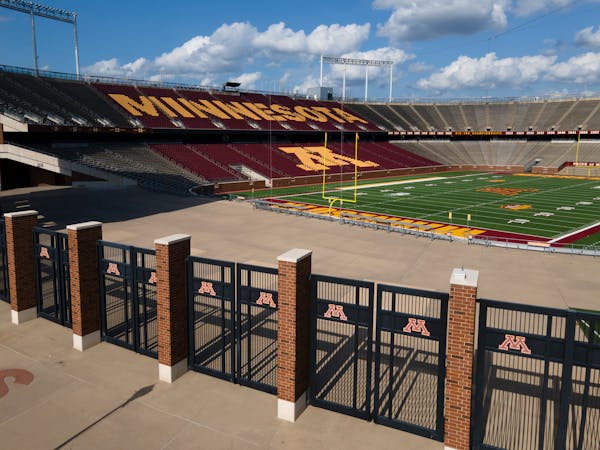After a COVID-19 outbreak, the Gophers football team is already in the process of returning to practice in preparation for one of its final games on Dec. 12 at Nebraska.
With a steep decline in additional cases, just two players reported positive in the most recent update this past Thursday, the Gophers seem ready to breathe a sigh of relief and carry on with the rest of the 2020 campaign. But those 49 cases — 23 players and 26 staff — since Nov. 19 leave many questions unanswered.
Both athletic director Mark Coyle and coach P.J. Fleck professed to not know how the virus infiltrated and spread through nearly 30% of the program, both just calling it the "ghost in the room." Fleck has asserted his players didn't act irresponsibly in joining the nearly 340,000 Minnesotans who have been infected with the virus.
The Gophers are not alone in their struggles, as the recent surge in cases across the country has proved. COVID-19 has postponed or canceled more than 115 college football games so far this season. Wisconsin and Maryland both missed two games, as the Gophers will, with outbreaks that peaked at 30 cases. Ohio State and Michigan have recently canceled games with an unspecified number of cases.
That lack of transparency and universal policy has made navigating college football's COVID-19 spread difficult. For example, the Big Ten Conference does not appear to have a uniform rule for how teams should deal with contact tracing and close contacts. When the Illinois starting quarterback tested positive earlier this season, he sat out the mandatory 21 days for isolation, cardiac testing and recovery, per the conference protocols. But his backup also sat out about 14 days for close contact, the recommended time. Illinois never had to shut down or miss a game.
The Gophers, though, have said that because the Big Ten requires daily rapid-results testing, the need for that kind of contact tracing is greatly reduced. The team does determine who might have come in contact with a positive case but doesn't require those people to sit out any length of time.
Even since the Gophers paused team activities Nov. 24, returning to light acclimatization workouts Wednesday, they weren't in full quarantine, except for positive cases, who isolated for 10 days.
Ryan Demmer, associate professor in the university's School of Public Health, said daily testing could shorten the quarantine time for close contacts, but it doesn't eliminate the need for it. The Big Ten did not return requests for comment, but it's likely any kind of close-contact policy could wipe out entire teams and their recent opponents from playing, which could be why schools are left to decide their own practices.
For the Gophers, though, it might have helped. It's likely of the 170 players and staff tested six days a week, several brought the virus in from the outside — such as from players possibly spending time with friends not on the team or coaches going home to their families with children in school. Even if the team's social distancing, masking and hygiene were perfect, the act of practicing together with all the contact that entails makes some spread inevitable, especially considering the timing of the off day for testing.
For example, it's possible a player could become infected right after a test administered Friday. His virus load was too low to test positive Saturday, or he produced a false negative. The team didn't test Sunday. And it's not until Monday he tests positive and is put into isolation. Demmer said it's hard to know exactly when people become contagious and just how contagious they are, especially since many of the Gophers' cases have shown mild to no symptoms, but it's likely within two to three days of infection. So that one player could have been unwittingly positive and spreading the virus for several days.
Because virus sequencing is expensive and time-consuming, the exact cause of the Gophers' outbreak might never become clear. Just as it will likely remain unknown how this might have rippled beyond the Gophers.
"To what degree are teams like this really fueling community spread?" Demmer posited. "Can you draw direct lines between Gophers players becoming infected and people landing in an ICU?"
For that reason, Demmer said he thinks the responsible action now is to pull the plug on the season. The Gophers will likely have a depleted team for any remaining games because of the lengthy inactive policy.
"It really tells you the challenge we're up against as a society when they have access to that much testing and still at least half if not three-quarters of the team has probably been affected," Demmer said. " … We have really high community rates at this point in time, and that has far-reaching effects, even in a system where there's that much testing and care being taken to avoid risk."
At this point, though, the Gophers' outbreak has already raged, making any potential consequences both within and outside of the team irreversible. And daily testing, despite it being one of the strictest protocols in sports and a main reason why the Big Ten decided to un-cancel the season, wasn't quite the catch-all solution many hoped.
"It certainly helps a lot, but it's not foolproof," said Kris Ehresmann, the Minnesota Department of Health infectious disease director. "That's why I'll go back to the vaccines as the light at the end of the tunnel."
Right-wing conservatives object to Vista's deal to sell Federal ammunition to Czech firm
Coyotes officially leaving Arizona for Salt Lake City following approval of sale to Utah Jazz owners
Inappropriate exchange between columnist, Caitlin Clark mars news conference
Ryan Pepiot pitches 6 strong innings as Rays beat Angels 2-1

